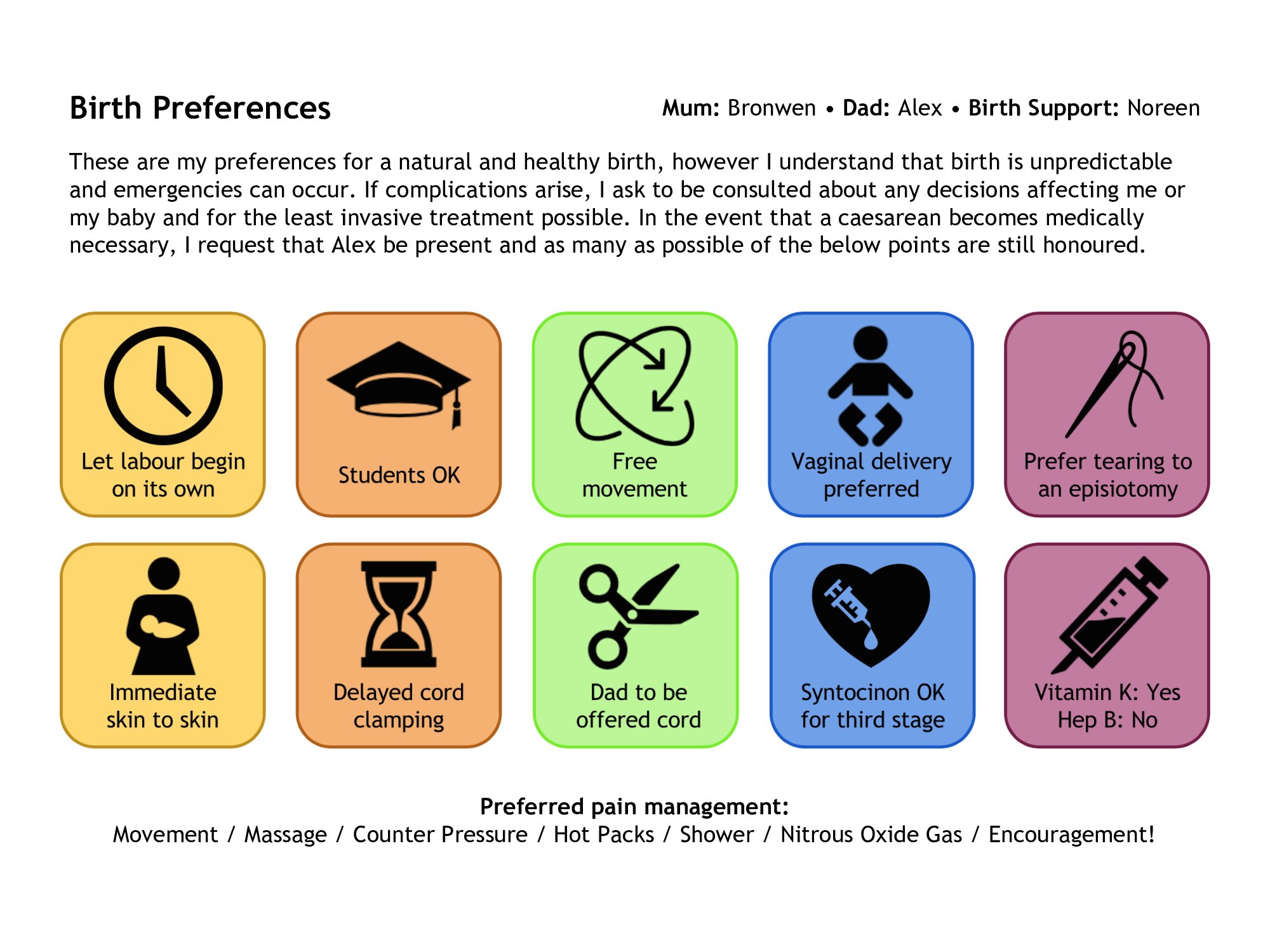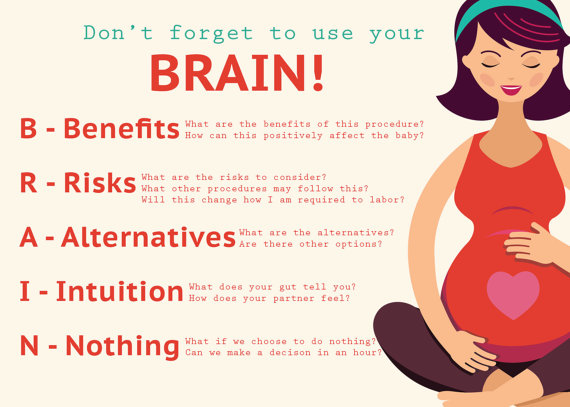Why Midwives Love a Good Birth Plan
This week I am thrilled to feature a guest post from midwife, Kate Visser.
Birthwell Birthright (BWBR): Many people are very cynical of the whole concept of a “birth plan”. Pregnant women hear all too often from their friends that birth plans are a waste of time. We also hear of some midwives and doctors who also think that birth plans aren’t worth the paper they’re printed on. What are your thoughts? Is it just a problem with the word “plan” or is there more to it than that?
Kate Visser (KV): The words “birth plan” have become dirty words amongst society and birth professionals. I suppose it inherently comes from the idea that we can plan a lot during our lives, such as our education, career, purchases, holidays and relationships. What we can’t 100% control are two major life events – birth and death. Or can we? We live in a world that likes a high level of control, hence where the notion of a birth plan originated from. We all know someone who wanted a natural birth. She’s independent, educated, and possibly your friend or sister. She planned a natural birth, she even authored the script for her labour. She agreed with whatever intervention was proposed to her by her healthcare provider because she trusted that they ‘know best’. She probably wound up being induced because she had been pregnant for “too long” or her labour was “too slow”, and somehow ended up with a caesarean.
As a midwife, I’m a specialist in normal birth. I love it and it’s what I do, but I see every day that birth isn’t something that we can meticulously plan. If we could, we’d all be happy humans who had the best day of our lives. There is almost always inevitably one thing that is unexpected during your experience, and sometimes many. You can’t control it all. But that’s not what birth plans are for.
A birth plan isn’t a script. It’s a practical wishlist, a preference list, a document that assists your healthcare provider in best assisting you.
If we know you are someone who likes to be alone, we can support you in that. If we know that you find comfort in a bath, we can run one for you. If we know you had a difficult birth last time with an epidural and posterior baby, don’t want history to repeat itself, then we can use every trick in our midwifery book to turn your baby and give you some relief with other methods. Birth plans are valuable. They require you to do your research during your pregnancy, and discuss your options.
Some of what a birth plan consists of is what you would or wouldn’t like, particularly in relation to your support network and immediate postpartum cares. However the rest of it is the how. It’s the nitty gritty stuff that’s going to help you get the birth you want. If your desired destination is a spontaneous, vaginal birth, but you have no road map to get there, you’ll likely end up on the messy route your friends talked about and at a destination far from where you wanted to be. Ask questions, understand common interventions, consider what YOU want to do. Don’t worry what anyone else thinks about your birth plan, or the notion of having one. No one else is carrying, birthing or raising this child. Now is the time to start doing what is best for you and your family.
BWBR: In your opinion, what’s a more appropriate term to use?
KV: This is a challenging one. In practice I refer to is as a birth plan, but discuss it as a birth wishlist or birth preferences. The words “birth plan” are so culturally ingrained now. It will take an army of women to change the term. However, if women started using birth plans with the focus of being practical and positive, rather than prescriptive and negative, there wouldn’t be a need for a change.
BWBR: I’m sure you’ve seen a fair few birth plans over the years! Do you recall any really interesting or unusual requests or preferences that people have listed?
KV: I’ve definitely seen some interesting ones. I fondly recall attending a woman during a waterbirth who had a very lengthy birth plan. She requested that under no circumstances do I speak to her during her labour, but in another paragraph wanted to give consent to all intervention or monitoring. When it came to listening to the baby’s heartbeat, I whispered to her partner, who then whispered in the woman’s ear, to which she nodded her head. It was a giant game of Chinese whispers every 15 minutes for a few hours. Another one involved the woman wanting her partner to actively be involved in physically supporting her in the bath. This was lovely as there wasn’t a great deal of places for her to hold onto or rest in between contractions. What they didn’t detail on their birth plan was that their belief in pants for both of them was optional. I quickly used my midwife voice and pants magically appeared on her partner!
BWBR: If you were to give someone a list of things to ideally include on their birth preferences, what would you advise them to have on it?
 KV: I encourage women to consider their five senses. What do you want to look at? Pictures of your children, your partner’s eyes, a familiar landscape that is calming. What do you want to smell? Essential oils, your favourite blanket, your pets or partner’s cologne. What do you want to taste? Cold water, a muesli bar, chocolate. What do you want to hear? The voices of your loved ones, an encouraging meditation track, your favourite music, water running or trees rustling. What do you want to feel? Warm water on your back, your partner’s arms holding you up, a stress ball between your hands, your doula squeezing your hips. This is most helpful during labour and is focused on a woman’s personality, likes and dislikes.
KV: I encourage women to consider their five senses. What do you want to look at? Pictures of your children, your partner’s eyes, a familiar landscape that is calming. What do you want to smell? Essential oils, your favourite blanket, your pets or partner’s cologne. What do you want to taste? Cold water, a muesli bar, chocolate. What do you want to hear? The voices of your loved ones, an encouraging meditation track, your favourite music, water running or trees rustling. What do you want to feel? Warm water on your back, your partner’s arms holding you up, a stress ball between your hands, your doula squeezing your hips. This is most helpful during labour and is focused on a woman’s personality, likes and dislikes.
Focus on common hospital interventions too. This takes research and asking lots of questions. Women often find, particularly with their first pregnancy, that as they read and learn about normal birth, they also discover that rather frequently that hospital policies and common practice contradict with best evidence around normal birth. You will make SO many decisions and choices for yourself and your new family, and they start from early pregnancy. Practice researching, being intuitive, asking questions. Consider who your care provider will be. This can have a profound impact on your birth. Where would you like, or are able to birth? What kind of monitoring do you consent to during labour? What routine newborn cares are you happy to consent to? Consider your options from early labour, through until 4-6 hours post birth. If this is your first pregnancy, this may raise more questions than answers. I encourage you in all that you read, hear and see to use the acronym BRAIN. This is something I encourage women to use for simple decisions, right through to the big stuff that really matters. It stands for Benefits, Risks, Alternatives, Intuition and No, Not Now or Nothing (as in, “what would happen if we did nothing?”)
BWBR: Conversely, what would you advise them NOT to include?
KV: Great birth plans are specific and show that you have done your research. Steer clear of long plans with wishy washy language. One page is plenty. The specific things to avoid are those that are routine such as requesting minimal lighting, quiet voices, that you can eat and drink as you please, and your partner be involved. When in doubt, consult with your healthcare provider. This will guide you in what is standard practice, and what may require extra support or preparation.
BWBR: What would you suggest is beneficial in terms of the language or tone of a person’s birth plan? What sort of language is NOT helpful?
KV: I can’t stress enough how beneficial positive, affirmative language is when writing a birth plan. Conversely I can’t stress enough how non-beneficial negative, rigid language is. I recommend women start requests with “we would appreciate if…”, “we would like/love to…”, “we desire to…”, “you can support us in our goals best if you…”. Refrain from “we don’t want…”, “under no circumstances will we…”, “please don’t…”. We want to help you, and develop a healthy relationship with you during this time. We want to be your biggest advocate during a time when you are most vulnerable. Welcome us positively on this journey with you, and we will give you our heart and soul. On the contrary, a cold and restrictive birth plan with negative language can very quickly build a barrier between you and your midwife. Make the most of us. We are experts in normal birth and want to help you during one of the most amazing and transformative times of your life.
 BWBR: Some people are coming up with visual birth plans, rather than traditional written ones. What are your thoughts on this style of birth plan?
BWBR: Some people are coming up with visual birth plans, rather than traditional written ones. What are your thoughts on this style of birth plan?
KV: Visual birth plans are very midwife friendly. One reason health care professionals have negative attitudes towards birth plans is because we are given plans that are three pages long, typed in size 8 font with no line spacing! I am thrilled when a woman has sat down and thought that thoroughly about what she would/wouldn’t like for this amazing, life changing experience, but I do not have the time (sorry!) to read that much. A quick page with visual references, such as those that have come out of The Positive Birth Book by Milli Hill are fabulous. Brief is best and visual plans achieve this. There is still a considerable range of images for a visual birth plan, and include all the common, supportive normal birth practices, high risk birthing options, elective caesarean birth plans and newborn cares.
BWBR: Do you think women should write a Caesarean birth plan as well as their preferences for a vaginal birth?
KV: Absolutely. The research says that women who have a birth plan are more satisfied with their birth experience than those that do not have a birth plan. This occurs regardless of the birth outcome. Writing down a caesarean birth plan does not mean you will have a caesarean, it simply means that those caring for you will be able to continue doing so in a personalized way, that honours and respects your wishes for you and your family. Again, ask questions of your healthcare provider. What routinely happens in an emergency caesarean? What are the differences during those first few hours? It is always easier to ask questions and prepare in advance than it is in those critical moments.
BWBR: As a midwife, what information on the birth preferences is most relevant for you in terms of being able to support a woman in labour?
KV: The birth plans I find easiest to use as a midwife are those that are practical. That means it either requires me to do something, or to guard the environment. For some women this may be utilising massage. While I’m rarely able to give 100% of myself to a labouring woman due to the other responsibilities in my role, I can support her in this and teach her support person how to massage. For other women they might not need me to ‘do’ anything. This might mean giving verbal encouragement in a moment of weakness and offering a drink of water. I regularly say to women “I don’t mind what you choose, so long as you are happy with the decisions you make, and are informed of the benefits and risks of those. This is YOUR body and YOUR baby”.
I want to know what natural pain relief methods you would like to try, and pharmacological ones as well if needed. I want to know your thoughts on routine hospital procedures and possible interventions such as fetal monitoring, intravenous cannulation, breaking your waters or using a synthetic form of oxytocin, called Syntocinon to speed up your labour, the process of birthing your placenta, and newborn cares after birth. The time to discuss your options and have preferences is during your pregnancy. Ladies, please know that firstly your hormones make you a far more people pleasing woman during labour, and I can guarantee that you won’t fully be able to take in all the information required to give informed consent to a procedure or intervention during labour. That’s not to say you can’t change your mind. You absolutely can. Birth plans are fluid. What I am saying is discuss all your options now, not in the moment.
BWBR: Final question! What would be your response to the woman who says; “birth plans are a waste of time. You can’t plan your birth and besides nothing ever goes to plan anyway. I’m just going to go with the flow.”
KV: The phrase “I’m just going to go with the flow” is one I hear far too often. I simply rephrase this statement back to women. “Whose flow do you want to go with?” I ask. I’m yet to have a woman state anything other than “Well, mine of course”. Birth plans aren’t an authored script of what’s going to happen. It’s a summary of your educated wishes and preferences that allow us to provide personalized care to you. If you “go with the flow”, I can assure you you’ll flow with the midwife caring for you, what she’s comfortable with and routinely does. You’ll flow with the obstetric-based policies and procedures that govern and direct how the maternity system runs. You’ll flow with the medical officers who are responsible for women birthing safely and efficiently, however often involving intervention. I have seen time and time again that even if you trust your health care provider, their ‘flow’ is so very different to what you’d choose if you had your time again.
The old saying of “fail to prepare, then prepare to fail” comes to mind. If you want to go with YOUR flow, write down what that might look like, research your options, chat with your midwife, think about what is comforting to you when tired, challenged and in pain. This is what a birth plan is. An educated, prepared woman is an empowered woman. If this is your first pregnancy, trust me when I speak on behalf of other women who have birthed and been there before. This birth matters. This experience matters. This birth will set the precedence for all others to come. There is responsibility in this birth, and thus your choices. You can have the birth you want, and be better than you ever thought possible.
 Kate Visser is a midwife living on the Central Coast of NSW. She currently works in Midwifery Group Practice at Gosford Hospital. She is passionate about empowering women to have their best birth, and assisting them in the transition to motherhood. Kate is working towards becoming a Lamaze Certified Childbirth Educator, as well as an International Board Certified Lactation Consultant. She enjoys spending her spare time reading, running and exploring with her husband.
Kate Visser is a midwife living on the Central Coast of NSW. She currently works in Midwifery Group Practice at Gosford Hospital. She is passionate about empowering women to have their best birth, and assisting them in the transition to motherhood. Kate is working towards becoming a Lamaze Certified Childbirth Educator, as well as an International Board Certified Lactation Consultant. She enjoys spending her spare time reading, running and exploring with her husband.

